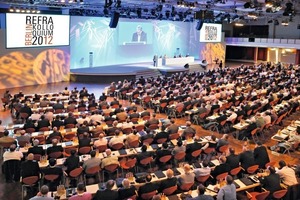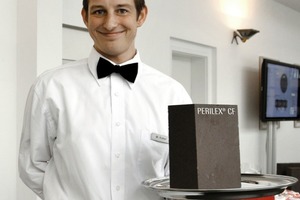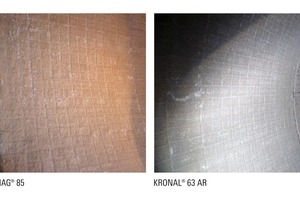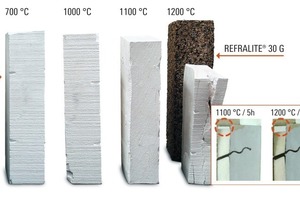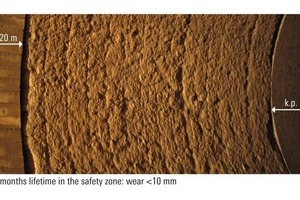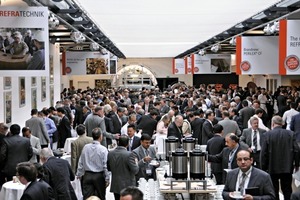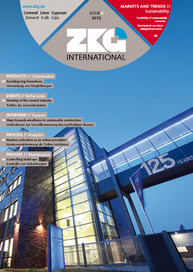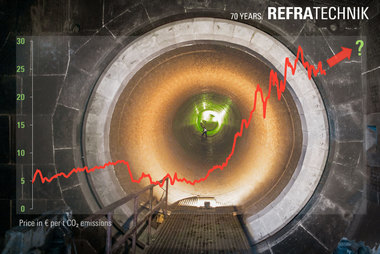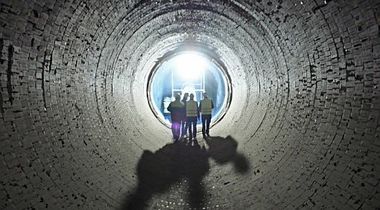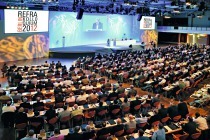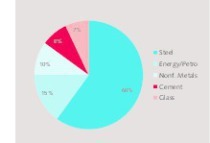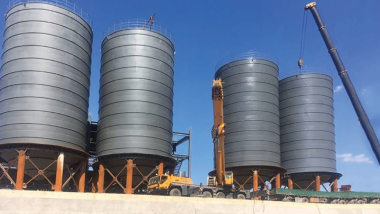Meeting of the cement industry
After the event was opened, Wolfgang Tabbert (Managing Director, Refratechnik GmbH) spoke about the most recent company development. Soon after the death of the owner, Alexander Tutsek, Refratechnik found itself in a good position to face the future – still under family management but in the form of two trusts. Constantly rising raw material prices remain a challenge for the future. However, the faith in the company’s vertical raw material integration, the expertise, the experience and the distinctive in-house grades has proved its worth for Refratechnik in recent years. Even during the crisis periods the company has been able to remain stable and it has not been necessary to dismiss any employees. The company is well placed with its new or refined products from the plants in Yingkou/China, Zibo/China, and plants 1–3 in Göttingen/Germany, Gochsheim/Germany and Gornal/Spain as well as a worldwide marketing and service network.
Ralf A. Hoffmann (Head of Global Macro and Risk Analysis, Deutsche Bank & Vice Head Deutsche Bank Research, Germany) then examined the worldwide and European financial growth in the light of the current Euro crisis. He pointed out that purely fiscal consolidation was not sufficient for sustainable stable growth. This is only possible with fundamental reforms. Germany had already carried these out about 10 years ago so it was now the strong country in Europe and could serve as a model for similar and much-needed reforms in other Euro countries. Mr. Hoffmann foresaw a stable situation for the BRIC countries, but pointed out these are by no means immune to similar crises. For the years 2012 and 2013 Mr. Hoffmann predicted moderate growth on a global scale although the economies would slow down in some countries.
This was followed by Philippe Fonta (Managing Director of the Cement Sustainability Initiative – CSI) who described the current situation in the development of the Cement Sustainability Initiative. The latest partner of the CSI is the “Association of Cementitious Materials Producers of South Africa”, which joined at the end of 2011. Mr. Fonta set out the 9 principle tasks that were identified by the members organized by the CSI. These are
CO2 and climate protection
responsible utilization of fuels and raw materials
safety at work
emission measurement and reporting
local effects on land and people
reporting and communication
concrete recycling
sustainability of concrete
water
Peter Groger (Executive Director Sales, Refratechnik Cement GmbH) began with a historical outline of cement production and the associated changes in the mechanical demand profiles for refractory linings. The static load in the first shaft kilns for cement production has given way to rising dynamic loads on the refractory material in rotary kilns. This technology reached its dimensional high point in the mid 60s of the last century with increasing thermomechanical loads in the wet- and dry-process kilns with lengths of over 260 m and diameters greater than 7.60 m. The meteoric rise in the use of alternative fuels and raw materials as well as increased outputs and kiln rotating speeds necessitate even more careful planning of the installation and selection of suitable brick types to meet the thermomechanical and thermochemical demands of modern cement plants. This is exemplified by new refractory materials that permit a high level of strain relief through relaxation. The TOPMAG® A1 introduced in 2006 and the ALMAG® A1 that was strengthened in 2011 are premium refractory products with low porosity, low permeability, high cold crushing strength and low modulus of elasticity. They are ideal for transition zones subjected to severe chemical and mechanical stresses, for tyre areas and for all the other mechanically stressed basic rotary kiln zones.
Dr. Hans-Jürgen Klischat (Director R&D and QM/QA Centre, Refratechnik Cement GmbH) then discussed the general properties of the Refratechnik product range, stressing the onward development of the PERILEX® high-volume product. Certain percentages of magnesium oxide and chrome ore in the microstructure provide a high level of elasticity combined with excellent refractory characteristics. The new chrome ore-free PERLEX® CF (Fig. 2) also exhibits these characteristic properties and with its chrome ore-free fused pleonastic elastification takes account both of the environment and of the requirement for an increase in performance. The marked thermo-elasticity also permits a high level of strain relaxation and therefore resists high mechanical load.
Holger Wirsing (Head of R&D Shaped Products Dept., Refratechnik Cement GmbH) used the example of the market introduction of the basic product FORMAG® 88 to illustrate the interdisciplinary cooperation within Refratechnik Cement GmbH from the specific needs of the customer to the qualification phase and on to global market introduction. This was followed by description of the specific properties of FORMAG® 88, which, together with the kiln feed, forms alite, belite, brownmil-lerite and calcium aluminates. This layer protects the brickwork by reducing the permeability and heat transfer and by providing beneficial coating properties. It is a highly alkali-resistant product that is ideal for lining the thermochemically stressed sintering zone.
Dr. Ulrich Zielinski (Area Sales Manager Europe, Refratechnik Cement GmbH) described various practical examples that showed how, through appropriate specific refractory design, basic products are used for innovative lining in modern kiln hoods that are exposed to severe thermochemical load to achieve record lifetimes of up to 9 years. Even complicated geometries and requirements can be realized by special shaped precast parts.
Juan Carlos Lozada (Project Director Grupo Gloria, Peru) then described the installation of refractory bricks in Line 3 at Cementos Yura S.A. A total of 3261 tonnes of refractory material was installed in this line. Materials containing SiC were used successfully in the critical areas in the project. In conjunction with Refratechnik Cement as the materials supplier and Refratechnik Mexico as the lining installer, suitable linings for various parts of the preheater tower, the calciner, the kiln and the clinker cooler were designed, supplied, installed and commissioned in a very short time and without any industrial accidents.
The programme for the 2nd day of the colloquium started with a lecture by Dr. Joachim Harder (Managing Director, OneStone, Germany). He gave a critical description of future scenarios for the cement industry. On a global scale the cement market will continue to depend on the growth in China. However, China will lose some of its importance within the BRIC countries. Countries like the CIS, Latin America, Africa and the Middle East will become increasingly influential. In general terms, energy-efficient processes, increased percentages of replacement fuels and lower clinker factors are the mechanisms for sustainable growth and will continue to keep the industry in business in the future.
Its production sites in China mean that Refratechnik is well positioned with respect to both existing raw materials and production capacities. Dr. Hilmar Schulze-Bergkamen (Head of R&D and QA Centre at Yingkou Refratechnik Refractories and Zibo Refratechnik Refractories, China) made it clear that Refratechnik also maintains very high quality criteria at its Chinese production sites. Production meets the European quality standards, starting with quality assurance for the raw materials. This statement was vividly illustrated with aid of a variety of production sequences ranging from raw material delivery, to moulding, production firing and QA.
Denis Franc (Refractory Coach of Lafarge Technical Centre Europe) showed how the Aberthaw plant, the Lafarge Technical Centre and Refratechnik Cement GmbH, as the refractory specialist, optimized the refractory lining (Fig. 3). In this plant the spotlight was permanently focused for years on short lifetimes when using standard materials and the usual lining concepts because of substantial mechanical problems. Innovative bonded brickwork was used with products from Refratechnik Cement GmbH consisting of KRONAL® 63 AR and ALMAG® 85 and a tailor-made installation solution. This more than tripled the service life!
Harald Merker (Technical Head of Project Dept., Refratechnik Cement GmbH) showed how a project can proceed. Empirical values and expertise must be included in the scheduling in order to achieve a plan that is realistic as possible. Raw material deliveries and the progress of construction on site are, in addition to other factors, parameters that Refratechnik Cement GmbH includes in the planning to ensure smooth execution, even if the construction work proceeds unexpectedly rapidly.
Klaus Kassau (Director of Refractory Engineering Dept., Refratechnik Cement GmbH) demonstrated impressively that although the refractory lining only accounts for a small part (approx. 1-1.5 %) of the budget cost, it can become a serious cost factor if it fails. He also gave a detailed explanation of the interaction in modern engineering services relating to all Refratechnik’s internal and external factors.
Kai Beimdiek (Head of R&D Unshaped Refractories Dept., Refratechnik Cement GmbH) then presented the latest developments with unshaped products. The optimum combination, including the chemical composition, for any application in the static parts of the kiln system can be produced on site with the MIXCRETE system, based on only 5 individual products and their miscibility. Significantly simplified warehouse stock, less working stock and a general reduction in costs can be achieved with the MIXCRETE system. These properties, coupled with excellent product service lives, mean that the MIXCRETE products are ideal for plant projects, conversions and modifications.
Dr. Stefan Lindner (Plant Manager of Rohrdorf Zement, Germany) described the refractory lining at the Rohrdorf Cement Plant that had been designed jointly with Refratechnik Cement GmbH. The modification of the kiln by Polysius, decided on in 2009, and the conversion of a planetary cooler to a modern grate cooler by IKN was completed on schedule in spite of the requirement profile, which was demanding as regards both time and space. A waste heat power plant, fed with central air from the cooler, is currently under construction for the plant in Rohrdorf. The world’s first SCR plant in the cement industry has already been installed in the clean gas circuit and successfully commissioned. About 1/3 of the electrical energy (approx. 7 MW) can be provided by the energy recovered from the waste heat power plant. To save time many parts of the cooler, e.g. the side walls, had been delivered to the construction site complete with the refractory lining that had already been fitted at the plant of the refractory installers, Möller. The aim was to achieve a short installation time with the best possible quality of lining. Accurate matching of the timing of all the process stages was naturally essential. The kiln hood was lined with REFRAMULLITE 63 JC on REFRALITE® 30 G insulation. The refractory material was applied very quickly using the JETCAST® process. The rear part of the cooler body with the side walls was lined with REFRACLAY 40 JC on REFRALITE® 30 G insulation. The parts subjected to higher thermomechanical load, like the horseshoe and the cooler side benches, were lined with REFRABAUXITE 85 JC AR and the end walls with REFRAMULLITE 63 LCC AR. The bullnose and the cooler roof were made with conventional standard bricks (bullnose with KRONAL® 60 AR, cooler roof mainly with KRONEX® 30). REFRALITE® 20 G, a special insulating gunning concrete recently developed by Refratechnik Cement GmbH, was used for the first time in the project in the collecting cyclones for the central air. Because of comparable geometries and operating conditions one of the double cyclones for separating the central air was lined with REFRALITE® 20 G and the other was lined conventionally with calcium silicate plates. The new lining exhibited good properties with respect to workability, insulation and thermal stability. The selection of materials, the installation and the design engineering have proved successful. Absolutely no spalling or erosion could be found in the heavily stressed areas like the bullnose after a year in operation. The kiln hood, which was lined completely using the JETCAST® process (some of it as AR lining) also required no remedial work after a year.
Stefan Thomas (Technical Manager of Project Dept., Refratechnik Cement GmbH) gave a more detailed presentation of the new REFRALITE® 20 G product. The static preheater stages with conventional calcium silicate (CaSi) insulation are often particularly affected by corrosion of the anchors and shell. This is because the temperature often falls below the dew point in these areas. It was therefore a matter of developing a material that in addition to having good insulating properties (Fig. 4) could also effectively minimize the corrosion. When compared with conventional methods of insulation the new, and also inexpensive, REFRALITE® 20 G product required only half the lining time and at the same time exhibited excellent dimensional and thermomechanical stability. The good insulating properties minimized the times when the temperature fell below the dew point, even with low outside temperatures. When the working lining is worn away the material still shows good emergency running properties compared with calcium silicate plates.
Dirk Basten (Technical Manager of Project Dept., Refratechnik Cement GmbH) provided an impressive illustration of the fact that wrong materials or inadequate lining can lead to damage that often only appears at a late stage but can then be very serious. Preventive or comparatively simple measures are often then no longer possible. So, for example, an after-expansion induced by mineral conversion in the presence of alkalis of alumina bricks that are lined in a suboptimal manner may lead to significant damages to the plant. This damage could be avoided with an optimum design. KRONEX® 20 and REFRACLAY 25, as siliceous products, are very resistant in these circumstances and in addition to their low bulk density and high insulating effect also represent a significant increase in performance. They now form part of the optimized standard layout in the static areas of new plants, rebuildings and modifications.
Lars Vieten (Technical Area Sales Manager, Refratechnik Cement GmbH) showed which materials can be used in the kiln safety zone that is affected by alkalis. KRONAL® 60 AR was developed specifically for the areas that are subjected to severe thermal and chemical stressing. In an example of its use Mr. Vieten was able to show that even with an AF substitution rate of 90 % in a kiln, the wear measured in the safety zone was only 10 mm after a lifetime of 28 months (Fig. 5). KRONAL® can reduce or even prevent ring formation. The product is also used in the static areas of the cement plant that are subject to severe chemical load, such as bullnose, calciner, kiln hood, etc.
At the conclusion of the REFRA-Kolloquium Angel Valtierra (Production Manager of the Palmar de Bravo plant, Cementos y Concretos Nacionales (belonging to the Cruz Azul Group), Mexico) described the Integral Service Package from Refratechnik using the example of the Palmar de Bravo Plant. The aim of the modernization work in this plant was to achieve a one-stop maintenance cycle per year. Refratechnik Mexico took care of the planning and the choice of materials, the machines, the tools and the personnel while Refratechnik Cement GmbH looked after the design engineering and the supply of goods. The Refratechnik Group used a detailed flow chart to synchronize with the plant in order to integrate the refractory work into the plant schedule. The aim of having to stop the plant only once per year for repairs to the refractories was successfully achieved and has continued to be so for a number of years.
An appropriate supporting programme provided plenty of opportunity to enlarge on what had been heard, to exchange views with colleagues from the cement industry and for networking (Fig. 6). Guests and hosts were able to see another side of Berlin together in a round trip by boat. A pleasant evening at Diedersdorf Castle, ending with a fireworks display, saw the start of future intercultural exchanges between participants from 70 nations. The very successful event ended appropriately with a fine gala dinner and the prospect of the REFRA-Kolloquium 2016.

